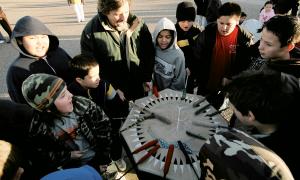author
1,480 Results
text
Informational
Home Was a Horse Stall
On December 7, 1941 Japan attacked Pearl Harbor and prompted the United States to enter World War II. While many Americans were concerned about the war abroad, they were also paranoid about the “threat” of Japanese Americans at home. As a result, many Japanese Americans were forced into internment camps on American soil.
August 22, 2016
article
article
Time to End the Game
When it comes to the damage inflicted by racist mascots and sports posturing, apologies are not enough.
text
Informational
Indian Occupation of Alcatraz
The announcement on November 20, 1969 from 89 American Indians – mostly students from colleges and universities – that they were taking over Alcatraz Island, set in motion what would become the longest occupation of a federal facility by Native Americans to date. This report aired a year later on NBC News, in December 1970, six months before the occupation ended.
July 3, 2014
text
Informational
Marcus Garvey and the Universal Negro Improvement Association
This segment examines black nationalist leader Marcus Garvey and his organization, the Universal Negro Improvement Association. Best known for his leadership in a "back to Africa" movement, Garvey's ideas would influence later black nationalist thought.
July 8, 2014
article
Summit Illuminates Immigrant Student Bullying
Last week’s Federal Partners in Bullying Prevention Summit in Washington, D.C., shone light on an often overlooked group—immigrant students.
article
Toolkit for "Segregation by Design"
This toolkit suggests ways to use primary sources to help students uncover the realities of segregation and how it was deliberately perpetuated in the United States.
article
Learning Lakota

For a high school on South Dakota's Rosebud Reservation, culturally responsive curriculum may be the best antidote to the violence, poverty and growing cultural disconnect hindering student success.
article
White Teachers at the Crossroads
Two leading multicultural educators reflect on how White teachers can help dismantle a legacy of racial domination and injustice.